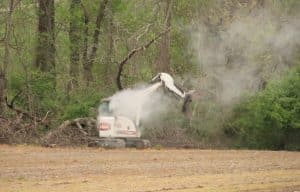Farmers eyeing successful soybean harvest
Although a broad spectrum of crops and farm animals are raised in Monroe County and surrounding areas, three basic crop building blocks are the foundation of the region’s dominant agricultural economy: wheat, corn and soybeans.
Wheat is being planted behind beans now for spring harvest. Corn will be drilled into the soil in the spring, and soybeans, planted both in the spring and as a second crop later in the summer after wheat is harvested, are now coming out of the fields and moving to storage or market.
The soybean harvest actually started two weeks ago, but was interrupted by a week of rain, which exceeded four inches in some areas.
Wheat and corn have both rewarded farmers’ hard work with bumper harvests, the wheat having been harvested in late May and early June, and corn now reaching its season’s end.
The U.S. Department of Agriculture is projecting a record soybean harvest of 3.9 billion bushels this year. Several local farmers said soybeans are looking good here as well.
Some of the beans planted in the bottoms early in the season were lost to Mississippi River flooding, while some later withered to a problem called “sudden death syndrome.” Various soil types have also provided different results.
Josh Matthews, who farms on Route 156 between Waterloo and Hecker, reported yields in the range of 40 to 60 bushels per acre from beans planted early in the spring.
“That’s a solid crop,” he said. “In the past, we’ve suffered from crops returning three to four bushels an acre. So this is much, much better.”
John Niebruegge of Valmeyer, who farms in the bottoms, reported he has harvested most of his first planting beans, with outputs in the 60 bushels per acre range.
“I lost 200 acres to river flooding early on,” he reported, “and had to replant that acreage.”
Niebruegge also reported sudden death syndrome losses. He attributed them to weather – a cold, wet spring followed by a cool, wet summer. He also said the dry August cut into crop returns.
But Niebruegge remained optimistic about the season’s overall soybean performance, which should be bolstered by second crop yields – possibly with record results – he said.
Matt Keller, who also serves as a crop specialist for Gateway FS, said he was just getting started harvesting after waiting out the recent rain. He classified the soybean yield as above average, with the second crop expected to sustain that good performance.
Matt Schmitz, who farms both near Renault and Valmeyer, finally was able to get into his fields this last weekend. Schmitz reported a yield in the 53 bushel per acre range in what farmers call “white soil” near Renault, with more than 70 in better soil near Valmeyer.
As did several farmers, he reported that some beans exhibited leaves that remained mostly green as the beans themselves ripened and dried. While this can cause challenges for combining, the beans were ready, farmers confirmed.
Schmitz also said his second crop beans look promising, and said some neighboring farmers were already getting their winter wheat planted right behind their bean harvests, in anticipation of next spring.
Bumper or large harvests can bring their own challenges, albeit mostly welcome ones, farmers indicated.
Farm returns are largely a matter of supply and demand. Short harvests raise prices and good harvests can likewise drive them down. Large harvests also cost more to harvest, transport and store. Such events as flooding can introduce unforeseen factors into the equation.
Other examples of challenges include reports from farmers that grain elevators to store crops are quite full and barges to send crops south for export are not easy to find. That can be a particular issue with soybeans, since 67 percent of the annual harvest will be sold overseas, with much of it going down the Mississippi River to New Orleans to load on ocean-going freighters.
While there is such a thing as crop insurance to cover some risks and losses, that costs money, too. At least one county farmer said he passes up crop insurance.
“So I don’t have to go to the casinos to gamble. I do that right down here on the farm,” he said.






